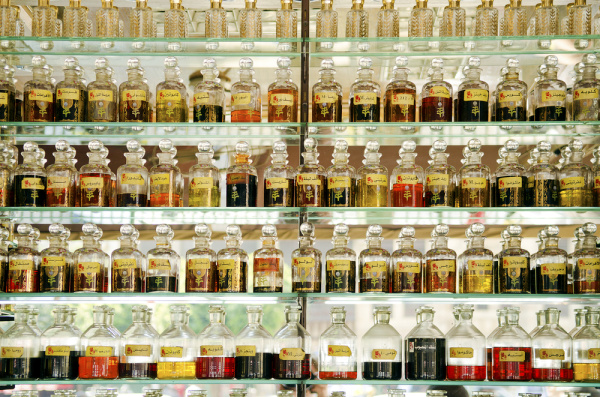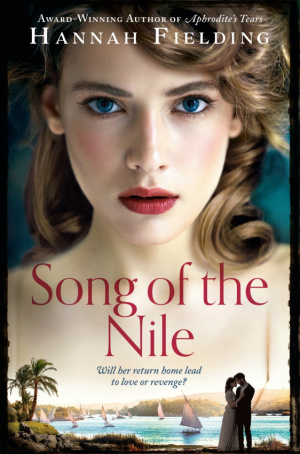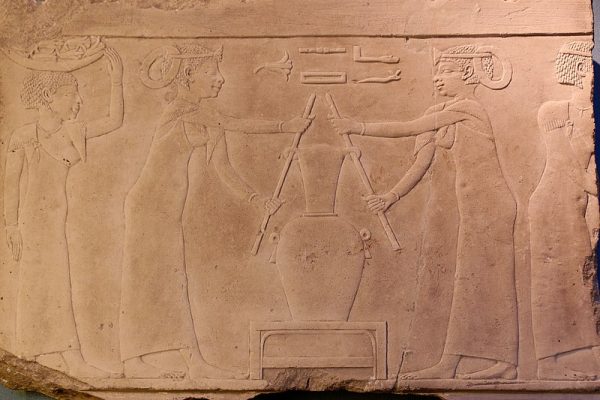Perfumes of Ancient Egypt
Perfumes of Ancient Egypt
Perfumes of Ancient Egypt
-
Hannah
-
Hannah

In Song of the Nile, Phares and Aida visit the Khan el-Khalili bazaar and souk in Cairo. There, in the labyrinthine alleys of the Musky, they step back in time to a world of scent and sensation, in the shop of a traditional Egyptian perfumier.
Here, amid spices and herbs, petals and roots, breathing in air redolent with cedarwood, ambergris and sandalwood, Aida waits while the perfumier, Suleiman, makes for her a signature scent. She watches him at work:
Suleiman rummaged among his wares, reaching with exquisite airs and graces towards an array of gummy bottles, measuring and pouring, sniffing occasionally, adding a pinch of this and a squeeze of that. Aida caught the elusive scent of lavender, of rose, and then a more subtle, spicy bouquet. The old man pounded something in a wooden bowl with a small pestle and the warm fragrance of carnations drenched the air.

Aida is somewhat dubious that this stranger will concoct a scent that she likes. When Phares tells her this scent will be her special fragrance, which will be redolent of her, she responds: ‘That’s very kind, Phares, but shouldn’t I smell it first? I’m not sure his idea of a nice fragrance and mine will correspond.’
But when the old man smears the oil he has concocted on her wrist and then asks her to sniff ‘the perfume of Arabia’, she is amazed:
The delicious fragrance filled her nostrils with full-blown roses, sweet almonds, airy musks, but also golden amber and sultry sandalwood, ending with the heady scent of carnation. Fresh, but also delicately warm. She sniffed again, then looked up at Phares before turning to the old man. ‘Mmm … I love it. Thank you.’
To Aida’s embarrassment, Suleiman names the perfume Nasmet El Aroussa, Fragrance of a Bride; to her further embarrassment, Phares insists on buying it for her, having declared it portrays well her ‘fresh innocence, but also undercurrents of rebellion and passion’. Still, Aida wears the scent from that day forth; the perfume is for her, as Coco Chanel put it, ‘the unseen, unforgettable, ultimate accessory’.

Song of the Nile: available to buy now
From where did Suleiman learn the art of perfumery? His family, I imagine: I picture his lineage having a talent in this art. Perhaps, even, he is imbued with some of the artistry of his far distant ancestors.
The Egyptians first created perfumes, in the form of incense, in about 3000 BC. Initially, they used perfumes in temples for religious ceremonies, but it soon became popular for people to use fragrances too, for the pleasure of smelling beautiful and for what they believed to be health benefits.
The Egyptians even had a god of perfume and aromatherapy, Nefertum, who had emerged from a lotus flower bud in the primeval waters at the time of creation and who became the son of Ptah. He was also a god of healing and medicine, among other things, and people wore amulets representing him for good luck.

Amulet of Nefertum, 1070–332 BC, The Met
During the time of the pharaohs, Egypt became renowned for its perfumes. There was Cyprinum, with cardamom, cinnamon, henna, myrrh and southernwood; Susinum, with lily, myrrh and cinnamon; Mendesian, with cassia and myrrh; and ‘the Egyptian’, with cinnamon, myrrh and wine. Kyphi was especially popular, containing saffron, raisins, cinnamon, myrrh, frankincense, honey, juniper berries and wine. The perfume of Ancient Egypt was an oily salve, not the liquid we use today, and it was rubbed on the body or burned as incense to make a smoke-based scent (the word ‘perfume’, in fact, is derived from the Latin ‘per fumus’, meaning ‘through smoke’).

Ladies making lily perfume; relief from a 4th-Dynasty tomb, Le Louvre
Modern-day scientists and perfumiers have since attempted to recreate Ancient Egyptian perfumes. Reportedly, the Osmothèque in Versailles has the Kyphi scent (the Osmothèque, if you are not aware, is the world’s largest scent archive, which strives to preserve all perfumes made now and in the past in order to trace the history of perfumery – a fascinating place to visit).
In 2012, archaeologists discovered, outside of Mendes, the home of perfume merchant along with his workspace. Here were perfume bottles and amphorae that contained the residue of two popular ancient perfumes, Mendesian and Metopian. According to the Smithsonian Magazine, ‘The researchers took their findings to two experts on Egyptian perfume, who helped to recreate the scents following formulas found in ancient Greek texts.’ The result was two strong, spicy, faintly musky scents which ‘no one has smelled for 2,000 years’. Apparently, Cleopatra, the last queen of Egypt, may well have worn these fragrances. Amazing!
So you can see that when I wrote the perfumery scene in Song of the Nile, I had in mind the long tradition of fragrance in Egypt. When I close my eyes, I am transported to that Musky shop, and I can almost smell all the aromas: spicy and sweet and musky and tangy. To borrow from Christian Dior, ‘the memory of perfume lingers’ – and that is its beauty.
Picture credits: 1) Dmytro Buianskyi/Shutterstock; 2) JM Travel Photography/Shutterstock; 3) The Met; 4) Jastrow/Wikipedia – Le Louvre.